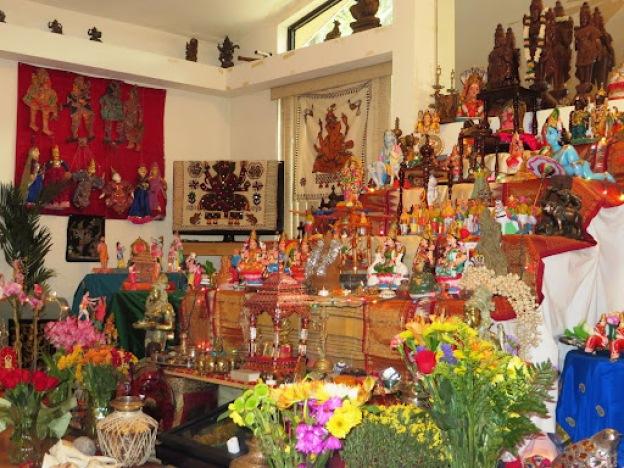Section Branding
Header Content
How to pass along religious traditions (without embarrassing your teenagers)
Primary Content
As many parents know, the line between passing along cultural traditions and mortifying your children in public can be perilously thin. For one mother, that dilemma arose this year ahead of Navaratri, a Hindu festival celebrating female strength that culminates today. One of the festival's key components is garba, an intricate folk dance from the Indian state of Gujarat.
Storyteller and playwright Nimisha Ladva says that some of her fondest memories are of attending Navaratri celebrations as a kid in England.
“Let's just start with the clothes,” Ladva said. “They have mirrors and tassels and bells. It’s maximum dress-up possibility.”
But the heart of these festivals was garba, and particularly the women dancing. “This is women taking up space literally, in a way that was different from normal life,” Ladva said.
Dancing with your kids without being cringe
Now teaching at Haverford College outside Philadelphia, Ladva wanted to share the thrill of garba with her daughters.
One problem, though. She had no moves.
“On a scale of one to 10,” she said, “I might make like a two.”
She wanted to improve. So this year, she enlisted the help of a coordinated friend to give Ladva and her two daughters garba lessons. They planned to test their skills at their local temple's Navaratri celebration.
Ladva's daughters, though, were not as enthusiastic — as 12-year old Himani revealed while chatting with her mom.
“How awkward is that going to be?” Himani said at their home in Wynnewood, PA.
“Would you like to be able to do some more of the steps?” Ladva asked.
“No,” Himani said.
Ladva’s other daughter, 15-year old Medha, was skeptical of the whole project.
“I love my culture,” she said, “and I'm happy to be Indian. But I'd rather learn organically with my friends or at a holiday.”
Still, on a recent Monday night, they pushed the furniture to the sides of their living room, and Ladva's friend, Minu Naik, started instructing Ladva and her daughters.
Celebrating women
Garba is performed in a circle, and you have to shuffle your feet and pivot while keeping pace with the the group. This was something Ladva struggled with. She lost her footing a couple times, apologizing for bumping into the others.
Afterward, Naik gave her assessment. “I think we all stumbled a little… but I think we got it…for now.”
The family laughed at her optimism.
Ladva is not alone among American Hindus, in her wish to embrace community during this festival.
Vasudha Narayanan, Director of the University of Florida's Center for the Study of Hindu Traditions, said that during the ten days of Navaratri, “The social life of Hindus in the diaspora is on steroids.”
Narayanan explained that in many regions of India, Navaratri highlights an underrepresented aspect of Hinduism. The religion is often seen as patriarchal, she said, but during this festival, “Women take the lead role...celebrating the creative energies of the goddess.”
In recent years, garba's become more commercialized, with viral YouTube videos, stadium performances, and promoted festivals. Aditya Bhattacharjee, a professor who teaches courses on transnational Hinduism at the Rhode Island School of Design, said, “Garba events have become a way for younger South Asians to explore their identities. They make preserving cultural heritage cool.”
But Nimisha Ladva worried that her family’s upcoming dance performance might actually drive her daughters away from these traditions.
“What if this goes so badly that they're like, ‘That's it, you will never drag us back’?” Ladva wondered.
A sense of belonging
Dragged or not, they all arrived at the Bharatiya Temple in Chalfont, PA on the first Friday evening of Navaratri. A line of cars stretched up the county road toward the domed Temple, lit up in green and blue above the dark fields around it. Inside, the Temple's auditorium was packed, as the announcer introduced participants in a garba contest that would take place before the general dancing.
Watching the skilled performers, Ladva noted the dancers' coordination. “They were literally dancing backwards,” she said. “I am taking it personally.”
Medha was also feeling the pressure. “I'm gonna, like, step on someone,” she said. “I just get cooked all the time in there.”
Before they knew it, the announcer was gathering everyone for a communal garba. It was time to join. Ladva took a deep breath.
Entering a Garba circle is a bit like jumping onto a whirling carousel. Ladva and her daughters eased up to the circle, then made their move. And soon, they were doing it! They shuffled, pivoted, and revolved in sync with the people around them.
After several turns, Medha stepped to the side to reflect on the experience.
“Sometimes I'm a little critical of my mom's cultural immersion schemes,” she said. “But, like, a few of the steps out there I felt like I [was] in the mix of it. So…not bad.”
Himani said that although she was mildly coerced into taking the dance lessons, the skills she acquired made her more comfortable than at previous Navaratri celebrations.
“I feel like I'd go…voluntarily to other events,” she said.
For Ladva, that meant this cultural immersion scheme had worked. And in the end, it wasn’t about her dancing skills at all.
“I shifted from trying to do a good job to trying to join in,” Ladva said. “There's a difference between wondering how you look and just feeling like you belong.”
After a short rest, Ladva was ready to dance again. She moved toward the music, and rejoined the circle of dancers.

